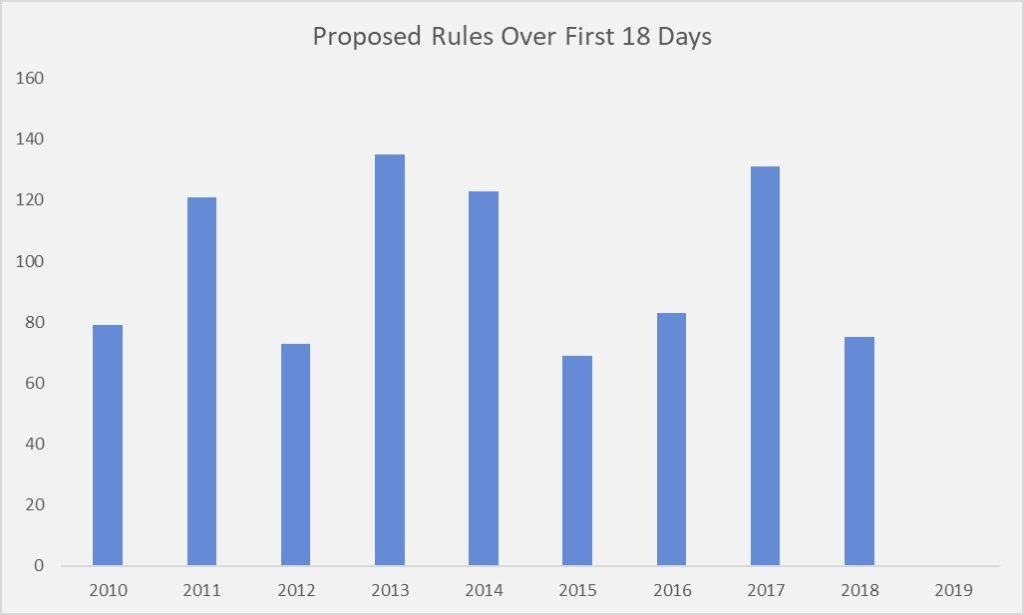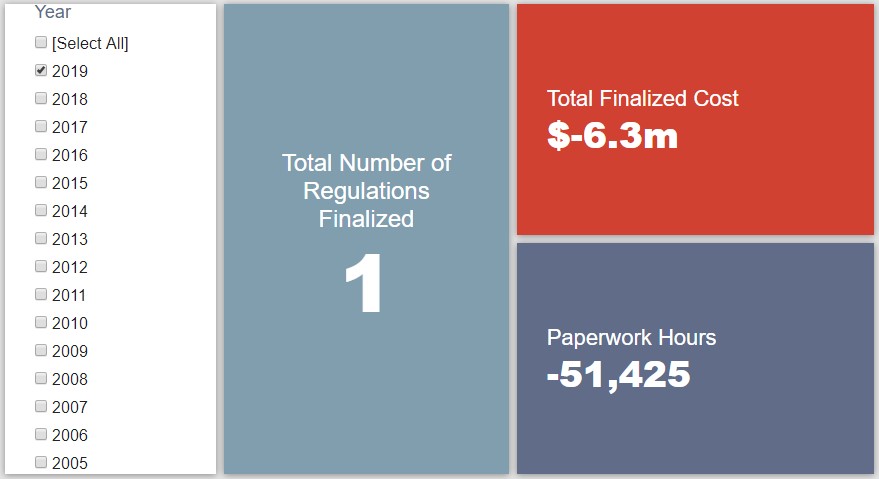Week in Regulation
January 22, 2019
Rulemaking Begins to Percolate
The winter weather remains chilly and negotiations over fully funding the federal government remain at a standstill. In the administrative arena, however, there are signs – albeit rather minimal – that the new year’s unprecedented regulatory deep freeze is beginning to thaw. A handful of rules passed Office of Regulatory and Information Affairs review and there was finally a rulemaking worth recording in RegRodeo.com. This single action out of the Department of Veterans Affairs (VA) starts off 2019’s official tally on the deregulatory side with roughly $6.3 million in total savings and 51,425 fewer hours of paperwork.
REGULATORY TOPLINES
- New Proposed Rules: N/A
- New Final Rules: 10
- 2019 Total Pages: 187
- 2019 Final Rule Costs: -$6.3 Million
- 2019 Proposed Rule Costs: N/A
TRACKING THE REGULATORY BUDGET
The rule on “VA Claims and Appeals Modernization” leads off calendar year 2019’s deregulatory actions. The rule implements part of the Veterans Appeals Improvement and Modernization Act of 2017 and VA estimates that it could produce nearly $6.3 million in cost savings over the next five years for affected veterans. Since it is a final rule, these savings apply to the fiscal year (FY) 2019 regulatory budget established under Executive Order (EO) 13,771. VA now stands at roughly $5 million in net savings. Considering its regulatory cap for FY 2019 is merely $0 in net costs, this action already puts VA ahead of its goal.
So far in FY 2019 (which began on October 1, 2018), there have been 23 deregulatory actions (per the rubric created EO 13,771 and the administration’s subsequent guidance document) against nine rules that increase costs and fall under the EO’s reach. Combined, these actions yield quantified net costs of roughly $1.4 billion. This, however, includes the caveat regarding the baseline in the Department of Agriculture’s “National Bioengineered Food Disclosure Standard.” If one considers that rule to actually be deregulatory, the administration-wide net total is approximately $5.3 billion in net savings. The administration’s cumulative savings goal for FY 2019 is approximately $18 billion.
THIS WEEK’S REGULATORY PICTURE
One can describe “regulatory policy” in many ways: mundane, opaque, monotonous, complex, legalistic. The list goes on. In order to help provide a clearer and more straight-forward view into this world, AAF will seek to provide a brief illustration of a notable regulatory trend we have identified in a given week. This week’s entry: a look at the still-abnormally stagnant pace of proposed rules.
Particularly astute readers may have noticed that, for the third week so far into 2019, the proposed rules line for the “Regulatory Toplines” section (see above) remains at N/A. Thus, while there has been some action in terms of final regulations, 2019 has yet to see any new regulatory proposals published in the Federal Register. The above graph shows how many “proposed rule” documents were published in the first 18 days of the year over the past 10 years. Considering that the previous nine years had an average of 99 such documents over that specific timespan, having a value of zero puts 2019 as a clear outlier.
This is important because actually unveiling a proposed rule is a key part of the time-consuming regulatory process. Delays in proposing rules necessarily mean delays in their eventual finalization. In regard to the administration’s regulatory budget, a weeks-long delay in the introduction of a deregulatory action may mean the difference between an agency meeting its FY 2019 goals or not. Other shutdown-related issues, such as an interruption in operations for the government’s primary electronic comment database, could further complicate the timeline for such actions.
TOTAL BURDENS
Since January 1, the federal government has published $6.3 in net cost savings and 51,425 hours of paperwork burden reductions. Click here for the latest Reg Rodeo findings.












